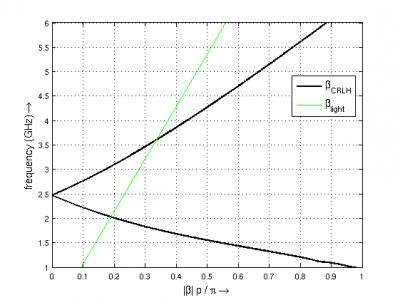Tutorial: CRLH Parameter Extraction
From openEMS
- Download the latest matlab files using Github: CRLH_Extraction.m & CreateCRLH.m
- Simulation Time: ~ 3 min
We will cover in this tutorial:
- setup a feeding mircostrip line & port
- apply an inhomogeneous mesh used for improved accuracy and simulation speed
- use an external script to setup a CRLH unit cell
- use the port voltages and currents to extract the unit cell equivalent circuit parameter
Contents |
First Steps
- Install and verify your openEMS installation: Tutorial: First Steps
- You may have a look at the tutorial introducing a MSL: Tutorial: Microstrip Notch Filter
Matlab Simulation Script
- Start the script within an empty environment:
close all clear clc
- Setup the simulation & geometrical parameter
physical_constants; unit = 1e-6; % specify everything in um feed_length = 30000; substrate_thickness = [1524 101 254]; substrate_epsr = [3.48 3.48 3.48]; CRLH.LL = 14e3; %CRLH totel (line) length CRLH.LW = 4e3; %CRLH unit cell width (without the stubs) CRLH.GLB = 1950; %CRLH gap width bottom layer CRLH.GLT = 4700; %CRLH gap width top layer CRLH.SL = 7800; %CRLH stub length (bottom layer, both sides) CRLH.SW = 1000; %CRLH stub width (bottom layer, both sides) CRLH.VR = 250; %CRLH via hole radius (stub -> ground) CRLH.TopSig = sum(substrate_thickness); %top layer height CRLH.BottomSig = CRLH.TopSig - substrate_thickness(end); %bottom layer height % frequency range of interest f_start = 0.8e9; f_stop = 6e9;
- Setup the FDTD parameter including the excitation time signal and boundary conditions
FDTD = InitFDTD('NrTs', 20000 ); FDTD = SetGaussExcite( FDTD, (f_start+f_stop)/2, (f_stop-f_start)/2 ); BC = {'PML_8' 'PML_8' 'MUR' 'MUR' 'PEC' 'PML_8'}; FDTD = SetBoundaryCond( FDTD, BC );
- Setup the inhomogeneous FDTD mesh and the CRLH unit cell
CSX = InitCSX(); resolution = c0/(f_stop*sqrt(max(substrate_epsr)))/unit /30; % resolution of lambda/30 mesh.x = [-feed_length-CRLH.LL/2 0 feed_length+CRLH.LL/2]; mesh.y = [-30000 0 30000]; substratelines = cumsum(substrate_thickness); mesh.z = [0 cumsum(substrate_thickness) linspace(substratelines(end-1),substratelines(end),4) 20000]; % create the CRLH unit cell (will define additional fixed mesh lines) [CSX mesh] = CreateCRLH(CSX, mesh, CRLH, resolution/4); % Smooth the given mesh mesh.x = SmoothMeshLines(mesh.x, resolution, 1.5, 0); mesh.y = SmoothMeshLines(mesh.y, resolution, 1.5, 0); mesh.z = SmoothMeshLines(mesh.z, resolution, 1.5, 0); CSX = DefineRectGrid( CSX, unit, mesh );
- A closer look inside the CreateCRLH function:
This function will add all the necessary metal objects composing a CRLH unit cell. Additionally it will add appropriate mesh lines as needed for a smooth mesh including a thin metal handling.
function [CSX mesh] = CreateCRLH(CSX, mesh, CRLH, resolution, translate) if (nargin<5) translate = [0 0 0]; end CSX = AddMetal(CSX, 'metal_top'); one_two_third = [-resolution/3 2*resolution/3]; start = [-CRLH.LL/2 -CRLH.LW/2 CRLH.TopSig]+translate; stop = [-CRLH.GLT/2 CRLH.LW/2 CRLH.TopSig]+translate; CSX = AddBox(CSX, 'metal_top', 10, start, stop); mesh.x = [mesh.x start(1) stop(1)+one_two_third]; mesh.y = [mesh.y start(2)-one_two_third stop(2)+one_two_third]; start = [+CRLH.LL/2 -CRLH.LW/2 CRLH.TopSig]+translate; stop = [+CRLH.GLT/2 CRLH.LW/2 CRLH.TopSig]+translate; CSX = AddBox(CSX, 'metal_top', 10, start, stop); mesh.x = [mesh.x start(1) stop(1)-one_two_third]; CSX = AddMetal(CSX, 'metal_bot'); start = [-(CRLH.LL-CRLH.GLB)/2 -CRLH.LW/2 CRLH.BottomSig]+translate; stop = [+(CRLH.LL-CRLH.GLB)/2 CRLH.LW/2 CRLH.BottomSig]+translate; CSX = AddBox(CSX, 'metal_bot', 10, start, stop); mesh.x = [mesh.x start(1)-one_two_third stop(1)+one_two_third]; start = [-CRLH.SW/2 -CRLH.LW/2-CRLH.SL CRLH.BottomSig]+translate; stop = [+CRLH.SW/2 CRLH.LW/2+CRLH.SL CRLH.BottomSig]+translate; CSX = AddBox(CSX, 'metal_bot', 10, start, stop); mesh.x = [mesh.x start(1)-one_two_third stop(1)+one_two_third]; mesh.y = [mesh.y start(2) stop(2)]; CSX = AddMetal(CSX, 'via'); start = [0 -CRLH.LW/2-CRLH.SL+CRLH.SW/2 0]+translate; stop = [0 -CRLH.LW/2-CRLH.SL+CRLH.SW/2 CRLH.BottomSig]+translate; CSX = AddCylinder(CSX, 'via', 10, start, stop, CRLH.VR); mesh.x = [mesh.x start(1)+[-1 0 1]*CRLH.VR]; mesh.y = [mesh.y start(2)+[-1 0 1]*CRLH.VR]; start(2) = -start(2); stop(2) = -stop(2); CSX = AddCylinder(CSX, 'via', 10, start, stop, CRLH.VR); mesh.y = [mesh.y start(2)+[-1 0 1]*CRLH.VR]; end
- Add the subtrate layer:
substratelines = [0 substratelines]; for n=1:numel(substrate_thickness) CSX = AddMaterial( CSX, ['substrate' int2str(n)] ); CSX = SetMaterialProperty( CSX, ['substrate' int2str(n)], 'Epsilon', substrate_epsr(n) ); start = [mesh.x(1), mesh.y(1), substratelines(n)]; stop = [mesh.x(end), mesh.y(end), substratelines(n+1)]; CSX = AddBox( CSX, ['substrate' int2str(n)], 0, start, stop ); end
- Add the two feeding MSL ports
CSX = AddMetal( CSX, 'PEC' ); portstart = [ mesh.x(1) , -CRLH.LW/2, substratelines(end)]; portstop = [ -CRLH.LL/2, CRLH.LW/2, 0]; [CSX,port{1}] = AddMSLPort( CSX, 999, 1, 'PEC', portstart, portstop, 0, [0 0 -1], 'ExcitePort', 'excite', 'FeedShift', 10*resolution(1), 'MeasPlaneShift', feed_length/2); portstart = [ mesh.x(end) , -CRLH.LW/2, substratelines(end)]; portstop = [ +CRLH.LL/2, CRLH.LW/2, 0]; [CSX,port{2}] = AddMSLPort( CSX, 999, 2, 'PEC', portstart, portstop, 0, [0 0 -1], 'MeasPlaneShift', feed_length/2 );
- Create the simulation folder/ write the xml file/ View the file using AppCSXCAD and run openEMS
Sim_Path = 'tmp'; Sim_CSX = 'CRLH.xml'; [status, message, messageid] = rmdir( Sim_Path, 's' ); % clear previous directory [status, message, messageid] = mkdir( Sim_Path ); % create empty simulation folder WriteOpenEMS( [Sim_Path '/' Sim_CSX], FDTD, CSX ); CSXGeomPlot( [Sim_Path '/' Sim_CSX] ); RunOpenEMS( Sim_Path, Sim_CSX );
Post-Processing
- Read the port voltages & currents and calculate the port characteristics
close all f = linspace( f_start, f_stop, 1601 ); port = calcPort( port{1}, Sim_Path, f, 'RefPlaneShift', feed_length*unit); s11 = port{1}.uf.ref./ port{1}.uf.inc; s21 = port{2}.uf.ref./ port{1}.uf.inc; plot(f/1e9,20*log10(abs(s11)),'k-','LineWidth',2); hold on; grid on; plot(f/1e9,20*log10(abs(s21)),'r--','LineWidth',2); l = legend('S_{11}','S_{21}','Location','Best'); set(l,'FontSize',12); ylabel('S-Parameter (dB)','FontSize',12); xlabel('frequency (GHz) \rightarrow','FontSize',12); ylim([-40 2]);
- Extract the unit cell parameter:
You may have a look at this paper [1] on CRLH parameter extraction details.
A = ((1+s11).*(1-s11) + s21.*s21)./(2*s21); C = ((1-s11).*(1-s11) - s21.*s21)./(2*s21) ./ port{1}.ZL; Y = C; Z = 2*(A-1)./C; iZ = imag(Z); iY = imag(Y); fse = interp1(iZ,f,0); fsh = interp1(iY,f,0); df = f(2)-f(1); fse_idx = find(f>fse,1); fsh_idx = find(f>fsh,1); LR = 0.5*(iZ(fse_idx)-iZ(fse_idx-1))./(2*pi*df); CL = 1/(2*pi*fse)^2/LR; CR = 0.5*(iY(fsh_idx)-iY(fsh_idx-1))./(2*pi*df); LL = 1/(2*pi*fsh)^2/CR; disp([' Series tank: CL = ' num2str(CL*1e12,3) 'pF; LR = ' num2str(LR*1e9,3) 'nH -> f_se = ' num2str(fse*1e-9,3) 'GHz ']); disp([' Shunt tank: CR = ' num2str(CR*1e12,3) 'pF; LL = ' num2str(LL*1e9,3) 'nH -> f_sh = ' num2str(fsh*1e-9,3) 'GHz ']);
- Calculate and display the dispersion diagram:
figure beta = -angle(s21)/CRLH.LL/unit; plot(abs(beta)*CRLH.LL*unit/pi,f*1e-9,'k-','LineWidth',2) grid on; hold on; plot(2*pi*f./c0*CRLH.LL*unit/pi,f*1e-9,'g-') ylim([1 6]) xlabel('|\beta| p / \pi \rightarrow','FontSize',12) ylabel('frequency (GHz) \rightarrow','FontSize',12) l = legend('\beta_{CRLH}','\beta_{light}','Location','Best'); set(l,'FontSize',12);



